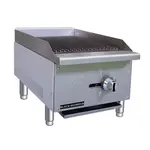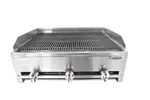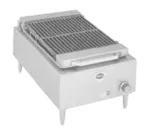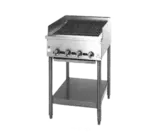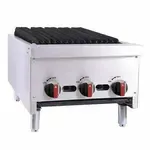
The Best Ribs for Smoking: Baby Back Ribs vs. Spare Ribs
If you’re running an establishment that offers outdoor cooking specials to its guests, ribs are an item that cannot be left out of the menu. With juicy meat and perfect flavors seeped into every last bite, ribs are customer favorites that can help you reap the rewards from your barbecue menu. So what are the best ribs for smoking? While this question might have several different answers depending on people’s subjective tastes, baby back ribs and spare ribs are among the most sought after when it comes to ribs, be it because of their meat content or juiciness.
Differences in the cuts of the meat affect the end product since factors such as size, thickness, meat content, and fat content are distinct. To help you make the most of your establishment’s outdoor cooking capabilities, we’ve put together a list of the best ribs for smoking, the difference between baby back ribs vs. spare ribs, the best wood for smoking ribs, and other information that will entice just about every barbecue lover in town. Read on to know more!
The Best Ribs for Smoking
Before we get down to discussing the differences between baby back vs. spare ribs, let’s take a look at some of the best ribs for smoking on the commercial grill:
- Baby Back Ribs
These ribs are by far some of the most popular options for smoking over a grill. The lean meat coupled with their shorter cooking times make for a relatively quick yet incredibly tasteful meal. Baby back ribs also happen to be the most popular ribs in butcher shops and grocery stores. Due to their high demand, they tend to be slightly more expensive than other ribs on the list. The tenderness and the lean meat make it ideal for an evenly smoked delicacy, replete with all the flavors of the seasonings and the smoky undertones.
- St. Louis Ribs
Known for their popularity in cook-offs and barbecue competitions, St. Louis ribs are the ideal choice for an evenly cooked set of ribs. They contain larger bones compared to their baby back siblings, however, the fat marbling in the meat makes it an irresistible choice for several chefs and amateurs alike. St. Louis ribs are a variant of spare ribs, with the main difference being that St. Louis ribs are trimmed to prepare a perfectly rectangular slab that can cook and smoke on the grill evenly. The rib tips and meat flap portions are removed, effectively earning them their very own category in the world of rib meats.
- Spare Ribs
These flatter ribs have high-fat content due to their proximity to the belly of the animal. They’re also high in meat content. Spare ribs are derived after the belly meat of the animal is sliced away. The top portion contains a thick layer of meat too, making these very sought after and also the most commonly available rib rack in the market. A standard spare rib often has at least 11 rib bones, making it a large slab. The fat content and the meaty nature of the cut make it the ideal rib for absorbing all the flavors from the seasoning and the smoker. This makes smoking the large spare rib worth all the effort.
What Are Baby Back Ribs?
Among the best ribs for smoking, baby back ribs are customer favorites you cannot avoid. They’re also called loin and Canadian back ribs. The term ‘baby’ arises not from the age of the animal the meat is sourced from, but refers to the size of the rib in comparison to the larger spare rib. A core difference between spare ribs and baby back ribs is the size. These come from the loin portion, and since Canadian bacon is sourced from the same area, these ribs are also popularly called Canadian back ribs. Baby back ribs have up to an inch of loin meat on the top, depending on the way they’ve been cut. These ribs are tender, leaner, and pricer. The average baby back rib rack weighs in at around 2 lbs and is usually capable of feeding only one customer since half their weight is bone. The baby back tapers to one end, usually the portion where the ribs meet the spine. They cook relatively faster than the other options and come with 11 to 13 ribs in a single cut.
What Are Spare Ribs?
These are often cut from the ends of baby back ribs. They have an end of exposed bone and the other end is close to the breast bone. The part near the breast bone has a flap of meat with cartilage and tiny bones, and the rib tips also lie close to this portion of the cut. Spare ribs are meatier and have more meat between the bones. Unlike baby backs, they don’t have much meat on top, an important distinguishing feature between spare ribs vs. baby back ribs. Spare ribs are flatter, with a greater length and a straighter angle. Spare ribs have two ends, with the exposed portion of the ribs denoting the portion where the spares were attached to the baby backs before being cut. Due to more fat and a wider connective tissue network in the spare ribs, the meat is more flavorful and more absorbent when compared to other cuts of ribs. Smoking a spare rib often produces a very rich taste loaded with flavor. Due to the presence of more cartilage and bone in the average spare back when compared to baby backs, they’re relatively cheaper. The average spare back rib weighs up to 3.5 pounds and should be plenty for two.
Baby Back Ribs vs. Spare Ribs: Core Differences
If you’re looking to truly capitalize on the potential your grill has to offer, it’s integral to know the major differences between baby back ribs and spare ribs. Here are some of the most important distinguishing characteristics of both cuts:
- Location on the pig’s body
- Where do baby back ribs come from? Baby back ribs come from the loin and back part of the pig. This is also why baby back ribs are referred to as back ribs or loin ribs alternatively. Baby back ribs contain the meat joined to the portion of the spine lying beneath the loin.
- Where do spare ribs come from? As opposed to baby back ribs, spare ribs come from the underside of the pig’s body. They begin where the baby backs end and run right up until the breast bone. This is why they have an exposed bone portion on one end and rib tips on the other.
- Meat Content & Type
- Not only are baby backs and spares distinct in location and size, but they’re also different in the composition of the meat.
- The location has a direct impact on the texture and flavor of the meat.
- Baby back meat is lean and has a lesser fat content. The meat, however, is tender and is located more towards the top of the rib rather than in between the individual rib bones.
- Conversely, for spare ribs, the meat is higher in fat, resulting in a marbled meat variety that is capable of taking up more flavor.
- Weight, Size & External Appearance
- Spare rib racks tend to be more variable in weight when compared to baby back ribs. Though 3.5 pounds is the average weight, variations are not uncommon.
- On the other hand, baby back ribs are more consistent, and usually weigh in at about 2 pounds across the board.
- While one end of the baby back rib rack can be between 6-7 inches, the other tapers down to 3-4 inches, giving it a characteristic appearance.
- On the other hand, spare ribs are more uniform in measure, and they remain in a loose rectangular shape throughout the rack without tapering.
- Baby back ribs are more curved, while spare ribs are flat. The bones on the latter rib are also more uniform and flat.
- Doneness & Temperature
- While you might have questions such as ‘At what temperature are spare ribs done?’ or ‘What temperature are baby back ribs done?’, the USDA recommends cooking pork ribs at least to an internal temperature of 145 F. However, the internal temperature at completion should be between 190 and 200 F.
- Price
- Though baby back ribs are pricier, this is not because of the content of meat on the rack, since the spare ribs have more meat on them. The price is driven purely by demand and by the higher percentage of lean meat on the cut. Baby back ribs are also more tender on average when compared to the spare variety - an important distinction between baby back vs. spare ribs.
Best Wood for Smoking Ribs
Now that you know the popular types of ribs and the differences between spare ribs vs. baby back ribs, it’s time to find out more about the best wood for smoking ribs. Here’s a list of wood types that are best suited to smoking ribs:
- Hickory
- Pecan
- Maple
- Oak
- Mesquite
- Apple
- Cherry
Factors to Watch Out for When Buying Ribs
Here are some attributes of ribs you need to bear in mind when you’re out buying ribs on a routine supply run:
- Visible Fat & Marbling: Make sure the ribs you choose have even marbling all over. Meat with large fatty areas tends to have gaps after being cooked. This can lead to uneven cooking and a dissatisfied patron.
- Thickness: Uniformity of thickness is an essential attribute of a quality rib. A rib with a uniform thickness will cook evenly on the grill.
- Color: Avoid picking discolored racks, or those with dried edges. Quality racks have meat that is between pinkish and red.
- Coverage: Also called meat coverage, make sure the rack you buy has ample meat coverage. The higher the exposed bone on the rack, the lesser the meat. Also, an increased number of exposed bones increases the risk of the bones falling out during the smoking process.
Both baby back and spare ribs are great choices for preparing pork ribs. Customers are bound to enjoy a classic, smokey delicacy full of flavor and juicy meat. Record each of your grill and smoke outcomes to fine-tune your recipes till you find the right consistency of flavor and texture in the meat.
